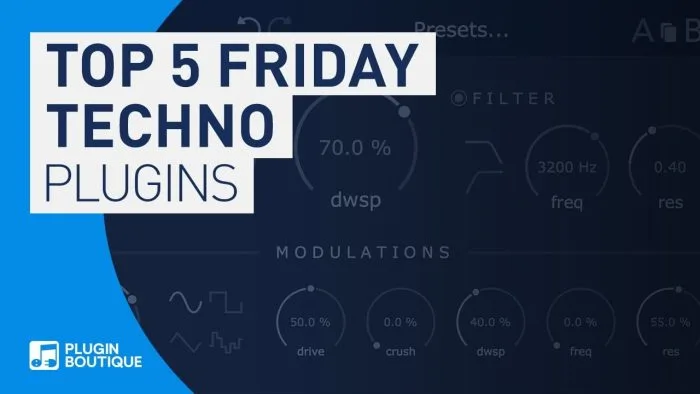Plugin Boutique has published a brand new Top 5 Friday round-up, this time taking a look at some plugins that are useful for producing Techno music.
Tim Cant breaks down his top 5 picks for plugins to use while producing Techno. Check them out below.
Perfect dystopian techno needs a perfect dystopian reverb, and FabFilter’s Pro-R is just that. Pro-R has all the hallmarks of any regular reverb plugin, with Space, Decay time and many more parameters, but it’s the lower half that makes it so versatile…
Here, the yellow curves act to EQ the reverb signal, and the blue curves change the decay time for different frequencies. This gives you a new way to emphasise or roll back different frequencies by changing their timing or their level.
Add to that the easy Brightness, Character, Distance and Width controls, as well as all your favourite reverb parameters, and you’ve got a workhorse reverb for any style.
If you’re mixing techno, you’re going to want some analogue distortion and saturation… and decapitator gives you exactly that, in five flavours – A, E, N, T and P – based on different types of distorting hardware circuits including tape machine preamp, channel strip, mixing console, and two hardware distortion processors.
Just push up the Drive to get things moving, and for the fuzzy cherry on top, there’s the Punish button to bring things right to the brink. Elsewhere, Decapitator has Low Cut, High Cut and Tone controls to customise the distortion to your liking.
3. Bass Line 3 (Audio Realism)
Roland’s TB-303 practically spawned techno, and we reckon that Audio Realism’s Bass Line 3 takes the biscuit in the world of 303 plugins. The idea behind ABL is to recreate the TB-303 as faithfully as possible, while also tacking on a few modern-day improvements and digital-world upgrades.
ABL3 nails the sound of the 303, and it adds in functions too, such as the Pattern Edit view, which lets you program notes for multiple parts at the same time, and includes loads of advanced tweaks for customising the VCO, the VCA, gate and accent response, and more.
This one also has a Wave Analyxer which can automatically transcribe 303 patterns to be played in ABL – very cool.
While the 303 provided the squelchy bass of techno’s birth, Roland’s TR-909 groovebox provided the beats, and odten still does to this day. D16 Group’s Drumazon is a bang-on emulation of the 909, and also offers some improvements of its own for the virtual world.
As well as using Drumazon with the in-built step sequencer, as is hallowed techno tradition, you can control the plugin using MIDI, getting your own gate lengths using note sizes. Other enhancements for the computer-based version include more parameters to tweak for the individual drum sound modules, DAW tempo sync, intelligent rescale, and a randomizer.
Roland’s Jupiter-8 is an 80s classic, a polyphonic synth that helped birth techno as a genre, but didn’t have any MIDI control onboard. But thanks to the wonders of plugin technology, you can integrate Arturia’s virtual version with the rest of your setup in your DAW.
Arturia have extended their Jupiter to 32-voice polyphony, included something called the Galaxy Module for advanced LFO patterns, and added keyboard splitting and layering.
If you’re looking for an authentic Jupiter-8 experience, but with none of the connectivity hassles or maintenance requirements – let alone the price tag – of the original unit, this is the one for you.
Check out these and more plugins and virtual instruments at Plugin Boutique.
 Save big with Plugin Boutique's 13th Anniversary Sale!
Save big with Plugin Boutique's 13th Anniversary Sale!
